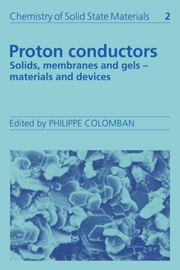Book contents
- Frontmatter
- Contents
- List of contributors
- Preface
- Symbols
- I HYDROGEN BOND AND PROTONIC SPECIES
- II MATERIALS: PREPARATION, STRUCTURES AND PROPERTIES
- III PROTON DYNAMICS AND CHARGE TRANSPORT
- 21 Incoherent neutron scattering studies of proton conductors: from the anhydrous solid state to aqueous solutions
- 22 NMR studies of local motions in fast protonic conductors
- 23 Vibrational spectroscopy of proton conductors
- 24 Raman spectroscopic studies of proton conductors
- 25 Frequency dependent conductivity, microwave dielectric relaxation and proton dynamics
- 26 Measuring the true proton conductivity
- 27 D.c. techniques and a.c./d.c. combination techniques
- 28 NMR in gels and porous media
- IV PROTON DIFFUSION MECHANISMS
- V DEVICES
- Index
24 - Raman spectroscopic studies of proton conductors
Published online by Cambridge University Press: 04 May 2010
- Frontmatter
- Contents
- List of contributors
- Preface
- Symbols
- I HYDROGEN BOND AND PROTONIC SPECIES
- II MATERIALS: PREPARATION, STRUCTURES AND PROPERTIES
- III PROTON DYNAMICS AND CHARGE TRANSPORT
- 21 Incoherent neutron scattering studies of proton conductors: from the anhydrous solid state to aqueous solutions
- 22 NMR studies of local motions in fast protonic conductors
- 23 Vibrational spectroscopy of proton conductors
- 24 Raman spectroscopic studies of proton conductors
- 25 Frequency dependent conductivity, microwave dielectric relaxation and proton dynamics
- 26 Measuring the true proton conductivity
- 27 D.c. techniques and a.c./d.c. combination techniques
- 28 NMR in gels and porous media
- IV PROTON DIFFUSION MECHANISMS
- V DEVICES
- Index
Summary
Introduction
Raman scattering spectroscopy is a versatile and powerful technique for studying composition, structure and dynamics in a wide variety of condensed phases. Transitions between vibrational states are measured in the usual Raman scattering experiment, as in an infrared transmission experiment. However, the selection rules governing Raman scattering differ from those of infrared absorption, so the two techniques should be regarded as complementary. Since the scientific literature regarding the application of Raman spectroscopy to studies of proton conductors is quite extensive, this chapter will not attempt to provide a comprehensive review. Rather the different kinds of structural and dynamical information which can be obtained from these studies will be surveyed, with examples given which illustrate the versatility and power of the technique.
In the next section, the theory of the Raman effect will be briefly reviewed, followed by Section 24.3, the application of Raman spectroscopy to studies of proton conductors. The description of structural information will be divided according to data obtained from band frequencies, intensities, bandwidths, and studies of phase transitions. The chapter will then conclude with several illustrations of dynamical information which can result from an appropriate analysis.
The Raman effect
Raman scattering has been the subject of numerous excellent reviews and will be only briefly summarized here. In general terms, an external electromagnetic field interacts with matter, inducing an oscillating electric moment which acts as a source of scattered electromagnetic radiation.
- Type
- Chapter
- Information
- Proton ConductorsSolids, Membranes and Gels - Materials and Devices, pp. 377 - 388Publisher: Cambridge University PressPrint publication year: 1992
- 1
- Cited by



